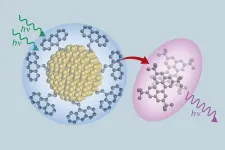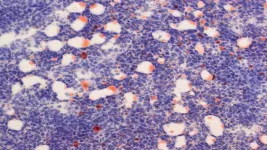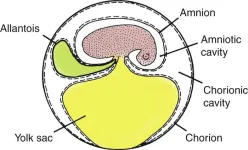(Press-News.org) COLUMBUS, Ohio – An international team of astronomers is the first to apply an old technique to discover a new type of planet that orbits two stars – what is known as a circumbinary planet.
As an added bonus, researchers found a second planet that is orbiting the same two stars, which is only the second confirmed multi-planet circumbinary system found to date. The study was published today in the journal Nature Astronomy.
Circumbinary planets were once relegated to only science fiction, but thanks to data collected from NASA’s Kepler mission, astronomers now know that multiple star systems are more common than previously thought. While many may not have planets of their own, roughly half the stars in the sky are made up of double, triple or quaternary formations. The other half are single stars like our sun, yet despite their quantity, scientists understand very little about the planets that form around multiple star systems.
“When a planet orbits two stars, it can be a bit more complicated to find because both of its stars are also moving through space,” said David Martin, co-author of the study and NASA Sagan Fellow in astronomy at The Ohio State University. “So how we can detect these stars’ exoplanets, and the way in which they are formed, are all quite different.”
The newly discovered system is called TOI-1338/BEBOP-1 for the planetary detection survey Binaries Escorted by Orbiting Planets, the team initiated to increase the number of known circumbinary planets. To date, it is only the second binary star system known to host multiple planets ever confirmed. Only 12 circumbinary planet systems have ever been discovered.
At the heart of their finding, the study revealed a large gas giant, which has an orbital period around the two stars of 215 days.
But what makes their discovery so special, Martin said, is how the planet was located. Of the more than 5,000 worlds that astronomers have found since the first exoplanet was discovered in 1995, most have been tracked down using a technique called the transit method. Widely considered to be the most effective way of proving the existence of other worlds, the method allows astronomers to indirectly detect a planet by measuring a dip in the brightness of light when a planet crosses between a star and an observer on Earth.
However, in this study, researchers detail the first-ever detection of a known circumbinary planet solely using observations made with the radial velocities method, an approach that relies on measuring the gravitational shifts planets exert on their host stars over time. It’s the same approach used to find the 1995 exoplanet, now known as Dimidium.
“Whereas people were previously able to find planets around single stars using radial velocities pretty easily, this technique was not being successfully used to search for binaries,” said Martin.
It’s because radial velocities, while successful at detecting planets around single stars, have historically struggled to find planets in binaries where there are multiple sets of stellar spectra, he said. Yet by targeting binaries where one star is much brighter than the other, the BEBOP program could soon help find many more, said Martin.
Previous research has shown that radial velocities could be used to locate a planetary system astronomers were already aware of called Kepler-16, but this study advances that work by discovering a brand new planet.
The discovery could also bode well for scientists devoted to looking for life on other planets, as according to the study, the inner planet already found in this binary system would be a prime candidate for atmospheric study by the James Webb Space Telescope. Atmospheric characterizations search for proof of biological activity and assess the likelihood of a planet having conditions conducive to life as humans on Earth know it.
If NASA does choose to turn Webb’s eye toward the planet in this study, it would be the first system of its kind amenable to atmospheric investigation, Martin said. “If we are to unveil the mysteries and intricacies behind circumbinary planets, our discovery provides a new hope,” he said.
Their work was supported by NASA, the European Research Council and the European Southern Observatory (ESO).
#
Contact: David Martin, Martin.4096@osu.edu
Written by Tatyana Woodall, Woodall.52@osu.edu
END
– By Christina Nunez
The U.S. electric grid faces simultaneous, evolving pressures. Demand for power from the grid is increasing as people adopt electric cars and building energy is transitioned from gas to electricity. At the same time, climate change is driving more extreme weather. Events like the 2020 heat wave that led to rolling blackouts in California are relatively infrequent, but they are happening more often – and utilities need to be ready for them.
New research points to a flexible, cost-effective option for backup power when trouble strikes: batteries aboard trains. A study from the U.S. Department of Energy’s Lawrence Berkeley National Laboratory ...
Denise Hines, Associate Professor, Social Work, received funding for the study: "Understanding Male Intimate Partner Violence Victims from Racial/Ethnic Minority Communities."
Hines will lead a four-phase study on the experiences of male victims of intimate partner violence, with a specific focus on men from racial/ethnic minority communities.
She will conduct the study in four, simultaneous phases.
In Phase 1, Hines will conduct a survey study of male Intimate Partner Violence (IPV) victims, including 300 White men, 300 Black men, and 600 Latino men from both immigrant and non-immigrant communities within the United States. The survey will ...
Peter Becker, Professor of Astrophysics and Space Sciences, received funding for: "Scientific Support in Solar Physics, Remote Sensing, Space Weather, High-Energy Astrophysics, and Associated Scientific Fields."
As part of this project, Mason researchers will conduct research in collaboration with the Naval Research Laboratory (NRL).
Areas covered by this research include: space sciences research (encompassing solar physics and studies of the integrated Sun-Earth system); computational physics and computational fluid dynamics; high-energy astrophysics; instrumentation ...
Foteini Baldimtsi, Assistant Professor, Computer Science, received funding from the National Science Foundation for the project: "Collaborative Research: SaTC: CORE: Medium: Cryptographic accumulators and revocation of credentials."
The goal of the project is to design efficient revocation mechanisms for the Web PKI and beyond.
Baldimtsi and her collaborators will tailor cryptographic accumulators to the problem of credential revocation making certificate revocation mechanisms ...
Four Mason researchers received funding from the National Science Foundation for the project: "Collaborative Research: CCRI: New: CoMIC: A Collaborative Mobile Immersive Computing Research Infrastructure for Multi-user XR."
Bo Han, Associate Professor, Computer Science; Parth Pathak, Assistant Professor, Computer Science; Lap-Fai (Craig) Yu, Associate Professor, Computer Science; and Songqing Chen, Professor, Computer Science, are designing and developing the infrastructure for Collaborative ...
A group of scientists and engineers that includes researchers from The University of Texas at Austin have created a new class of materials that can absorb low energy light and transform it into higher energy light. The new material is composed of ultra-small silicon nanoparticles and organic molecules closely related to ones utilized in OLED TVs. This new composite efficiently moves electrons between its organic and inorganic components, with applications for more efficient solar panels, more accurate medical imaging and better night vision goggles.
The material is described in a new paper in Nature Chemistry.
“This process gives us a whole new way of designing ...
Dietitians say a keto diet could help you lose up to 10% of your body weight. These high-fat, low-carb meal plans trick the body into burning its own fat. They could also help fight a variety of cancers by starving tumors of the glucose they need to grow. On the surface, this seems ideal. But research suggests these diets may have a deadly, unintended side effect for cancer patients.
In mice with pancreatic and colorectal cancer, keto accelerates a lethal wasting disease called cachexia. Patients and mice with cachexia experience loss of appetite, extreme weight loss, fatigue, and immune suppression. The disease has no effective treatment and contributes to about 2 million ...
The earliest reptiles, birds and mammals may have borne live young, researchers from Nanjing University and University of Bristol have revealed.
Until now, the hard-shelled egg was thought to be the key to the success of the amniotes - a group of vertebrates that undergo embryonic or foetal development within an amnion, a protective membrane inside the egg.
However, a fresh study of 51 fossil species and 29 living species which could be categorised as oviparous (laying hard or soft-shelled eggs) or viviparous (giving birth to live young) suggests otherwise.
The findings, published today in Nature Ecology & Evolution, show that all the great evolutionary branches ...
WASHINGTON --- Researchers at Georgetown University’s Lombardi Comprehensive Cancer Center and colleagues who have been exploring the complexities of biochemical pathways involved in cancer development have found that a form of glucose, a type of sugar, is intricately linked to a pathway used to build DNA molecules. When this pathway is overactive, it can lead to cancer and resistance to chemoradiotherapy.
The findings appear June 12, 2023, in Nature Chemical Biology.
“For a good while, my lab has been exploring cell signaling and DNA transcription mechanisms by which cellular metabolism changes in response to environmental and genetic cues, with the goal of designing ...
Higher neighborhood density of unhealthy retail food establishments was associated with a higher risk of delivering a baby that was large-for-gestational age, according to a new study at Columbia Mailman School of Public Health, while neighborhoods with a high density of healthy food retail establishments was linked with a lower risk of giving birth to a baby that was small-for-gestational age. Babies born either small- or large-for-gestational age, a measure of birth weight adjusted for length of pregnancy, are at greater risk for long term health complications, but until now little was known about how neighborhood characteristics including walkability and the ...



